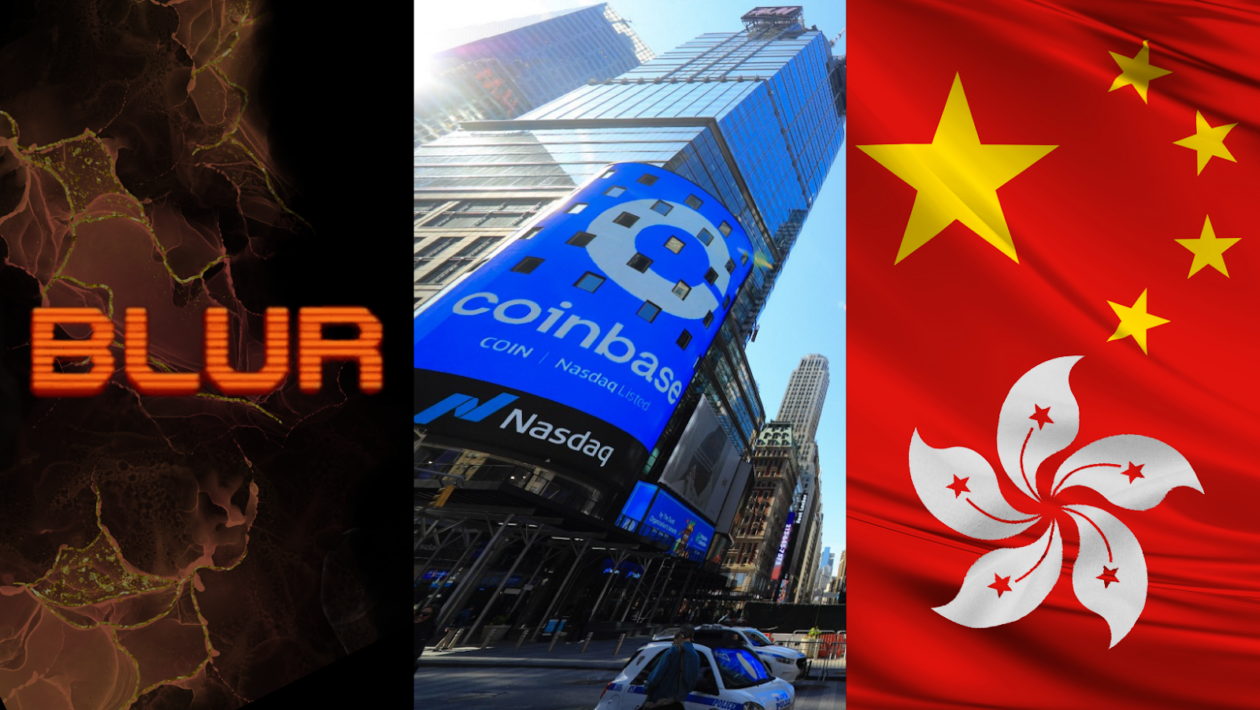In this issue
- Blur: Tricks of the trade
- Coinbase: Testing, testing
- Hong Kong: Crypto comeback
From the editor’s desk
Dear Reader,
“Watch what they do, not what they say” is one of the most solid ways of assessing developments in any sector — and, just as solid, if not more, in the crypto industry and digital asset space.
It’s a maxim that’s been frequently and conspicuously applied to the embrace of crypto by investment bank JPMorgan despite the fact that its chief, Jamie Dimon, has repeatedly disparaged the entire phenomenon. “Watch what they do,” indeed.
So, when it comes to recent news that the Chinese government has given authorities in Hong Kong the go-ahead to rebuild the city’s status as a crypto hub, we are certainly watching.
Given that mainland China has walled itself off from crypto industry development — despite having spawned some of the sector’s biggest success stories — Beijing’s stance on the matter is nothing if not intriguing.
However, as much as Beijing wants to keep crypto out of the mainland, it may be struggling to suppress its curiosity about it. Beijing thus appears happy to experiment with crypto on a small scale in the “laboratory” setting of Hong Kong.
Hong Kong stands increasingly as an expression of Beijing’s desire to experiment — even more keenly than in the past, thanks to the fact that Singapore recently snatched the city’s title as the world’s third-biggest finance hub. The territory has suffered not only in terms of its current finance center ranking but also from an exodus of talent that accelerated amid Covid-19 restrictions, which has left it looking for ways to shore up its economy.
So, in time-honored fashion, Hong Kong is setting itself up as a test bed for finance sector innovation. The city has reinvented itself before, and may be poised to do so again. And if Hong Kong is successful in fostering the development of a crypto industry that Chinese authorities don’t deem a threat to their own national prerogatives, the city’s crypto experiment could yet lead to a softening of attitudes to the industry in Beijing.
Watch what they do in Hong Kong and Beijing, and watch this space.
Until the next time,
Angie Lau,
Founder and Editor-in-Chief
Forkast
1. Fast times at Blur

By the numbers: Blur — over 5,000% increase in Google search volume.
At least US$577 million of wash-traded non-fungible tokens (NFTs) have been detected on the NFT marketplace Blur.io since the platform started airdropping its native tokens on Valentine’s Day.
- The wash trades involved suspicious behaviors such as resales within short periods at prices close to initial levels, suggesting that some Blur users have been selling NFTs to themselves using different wallets to acquire Blur (BLUR) tokens and accrue points for airdrops, according to NFT multi-chain data aggregator CryptoSlam. CryptoSlam and Forkast are both owned by parent company Forkast Labs.
- On Feb. 14, Blur released BLUR in a long-anticipated airdrop, giving users 60 days to acquire listing and bidding points on the marketplace, which keeps track of the top contenders through its airdrop leaderboard. Users can then receive BLUR via airdrop, and it can also be sold through centralized and decentralized cryptocurrency exchanges.
- The promise of gifting tokens has fueled a sales spike on Blur, which has recorded a trading volume of US$1.34 billion in the past 30 days, more than twice that of rival OpenSea, the largest NFT market by all-time trading volume, which recorded US$481.6 million over the same period, according to Web3 application tracker DappRadar.
- “All of this is a by-product of [Blur’s] war with OpenSea, said Scott Hawkins, a data engineer at CryptoSlam. “This token scheme has artificially distorted real activity in NFTs.”
- Wash trading, which is illegal in the traditional finance sector, remains a gray area in the unregulated NFT space. More than half of last year’s NFT trading volumes on Ethereum were attributable to wash traders trying to boost profits through the illusion of increased value, according to data platform Dune Analytics.
- Backed by crypto investment firm Paradigm, Blur was launched last October, rising to prominence and popularity thanks in part to its policy of charging zero marketplace fees.
- “There is no restricting mechanism from Blur to prevent this — in fact, it appears that because of no royalties [being] paid [and] no marketplace fees, there is no disincentive to farm points for airdrops, aside from rising Ethereum gas fees,” Hawkins said. “What we’re finding is that this is artificially propping up sales volume in a very disingenuous way for the entire NFT market.”
Forkast.Insights | What does it mean?
Wash trading has long been a problem in crypto. With the advent of NFTs, the market-manipulating scourge has infected that market as well. Blur’s meteoric rise highlights the fact that the industry lacks the ability or will to police itself.
Blur has insisted that it monitors the practice, but the three biggest traders and recipients of the most tokens are widely understood to have traded among themselves to inflate the value of their underlying assets. CryptoSlam’s recent discovery of the problem indicates the extent to which it has become endemic on the platform.
Blur has also begun marketing its next airdrop, dubbed Season 2, leading to another surge in trading volume as traders jostle for the biggest airdrops. The problem, as with so many things in crypto at the moment, is regulation.
In traditional finance in the U.S., wash trading is illegal under the 1936 Commodity Exchange Act (CEA), which covers cryptocurrencies like Bitcoin, but non-fungible digital tokens remain in a regulatory gray zone. Some 45% of the total NFT trading volume on Ethereum during the height of the NFT boom is now widely believed to have been attributable to wash trading. That proportion is thought to have been as high as 98% on some NFT marketplaces.
While the industry drags its feet when it comes to banishing the practice, trust in crypto’s already battered image will continue to erode.
2. Base layer

By the numbers: Coinbase — over 5,000% increase in Google search volume.
Coinbase Global, the biggest cryptocurrency exchange based in the U.S., has launched the testnet for Base, an Ethereum layer-2 protocol, as part of its venture into the Web3 developer space.
- Coinbase says Base aims to provide decentralized application (dApp) developers with a low-cost, open source and decentralized layer-2 environment that offers access not only to Ethereum but also to other layer-2 and layer-1 blockchains such as Solana.
- The launch date for Base’s mainnet has not been disclosed, and Coinbase does not plan to issue a new token for the Base network.
- Coinbase developed Base in collaboration with Optimism Collective, the governance organization behind Ethereum scaling protocol Optimism, and it will join OP Labs as a core developer of OP Stack, an open-source toolkit for blockchain developers.
- The price of Optimism’s native token, also named Optimism (OP), reached an all-time high of US$3.22 last Friday, an increase of over 20% from its opening price a day earlier, according to Coingecko data. OP has since retraced to US$2.78 as of mid-week in Asia.
- The Base testnet encountered glitches following its launch due to a bug in Coinbase wallets accompanied by massive traffic on the network, which a Coinbase engineer said had been resolved on Friday.
- Last September, Coinbase introduced Node, a tool for Ethereum developers to build and monitor Web3 applications, as part of an initiative to boost crypto adoption by supporting dApp builders.
- Meanwhile, Coinbase is facing challenges its centralized exchange business and recently reported Q4 net revenue that was 75% lower than that of the same period the previous year. The company, which was also recently hit by the U.S. Securities and Exchange Commission’s recent enforcement focus on crypto staking services, plans to cut 20% of its workforce by the second quarter of this year.
Forkast.Insights | What does it mean?
Coinbase is diversifying. The exchange has faced increased headwinds as regulation and dwindling consumer confidence have led to a slump in its exchange business.
The announcement of the protocol is, according to the exchange, part of a “secret master plan” to bring a billion people to its business. The reality is, perhaps, a little more down to earth.
U.S. regulators have taken a dim view of centralized exchanges offering staking services, which have become a significant part of Coinbase’s business.
For Q3 last year, Coinbase reported US$62 million of revenue from staking, or 10% of its total revenue for the period. It appears regulation could put an end to that.
Earlier this year, crypto exchange Kraken was fined US$30 million by American regulators in a case involving its staking services, which it subsequently shut down for U.S. customers, creating uncertainty about the future of exchange’s offering staking.
Coinbase is therefore looking elsewhere for revenue. Its move into the blockchain business harnesses its position as one of the main on-ramps for crypto users, especially in the U.S., giving developers direct access.
If Coinbase succeeds, its reliance on its other services — and the beneficence of regulators — will be reduced, giving its investors some much-needed relief.
3. Beijing’s blessing

Hong Kong’s bid to reclaim its status as a global crypto hub has gained discreet backing from authorities in Beijing, according to a Bloomberg report.
- Representatives from China’s Liaison Office in Hong Kong — the top mainland Chinese government agency in the city — have been frequent attendees at Hong Kong crypto gatherings in the past months, Bloomberg reported, citing unnamed sources.
- The report said the presence of mainland officials indicates Beijing’s low-key support for Hong Kong’s attempts to rebuild itself as a crypto hub and shows Chinese authorities’ interest in testing digital assets in the city.
- Despite the recent series of high-profile crypto exchange collapses, Hong Kong is pushing ahead in Web3. Last December, its legislature passed an amendment to a bill that included a licensing regime for virtual asset service providers, which is now open for public consultation and set to take effect on June 1.
- Under the new arrangements, Hong Kong’s Securities and Futures Commission may require cryptocurrency exchanges to apply for licenses that would allow retail investors to trade certain large-cap tokens, which are currently limited to professional investors with at least US$1 million in investable assets.
- Hong Kong introduced restrictive rules for crypto in 2018, preceding mainland China’s ban on cryptocurrency transactions in late 2021. But authorities in the city still see blockchain and digital assets as a potential driver of economic growth. In January, several Chinese state-backed entities launched the China Digital Asset Trading Platform, a regulated secondary market for non-fungible tokens (NFTs) in China.
- Hong Kong’s new crypto positioning is already attracting firms in the industry. Huobi Global, a crypto exchange that was founded in China but exited the country in late 2021, is seeking to move its Asia headquarters from Singapore to Hong Kong and to expand its local headcount from 50 to 200 this year.
- Exchanges OKX and Gate.io are also applying for Hong Kong crypto trading licenses, and some experts expect more Web3 companies to build businesses in the city.
- Apart from the virtual asset licensing regime, Hong Kong authorities are also ramping up regulation for stablecoins and investment in Web3 development.
Forkast.Insights | What does it mean?
As regulation has taken some of the wind out of the crypto industry in the U.S., Asia’s emergence as a hub for the industry’s future growth appears to be continuing.
Hong Kong’s renewed bid for crypto hub status suggests that China now sees the territory as a testing ground for the adoption of both private and public crypto infrastructure. China is already years ahead of many other countries in rolling out a central bank digital currency, in which Hong Kong has played a part. Via the real-world laboratory of Hong Kong, mainland authorities can now examine up close how a regulated crypto environment works out.
The region is ready for these explorations. Japan, Mongolia and Taiwan have seen impressive growth in the number of crypto transactions, which were up 113% in Japan from July 2021 to June 2022, according to Chainalysis. Hong Kong meanwhile, reported a 9.5% increase.
Despite concerns around China’s hardline stance towards the crypto industry and its reluctance to back down on what has been a concerted effort to ban it, Hong Kong’s repositioning has seen a surge of interest among Chinese entrepreneurs keen to build a business in the territory. About 70% of the 300 crypto firms applying to join Hong Kong’s accelerator program G-Rocket were set up by Chinese entrepreneurs. In China, which Hong Kong is part of, little happens without the national authorities’ blessing — or purposely looking the other way.




